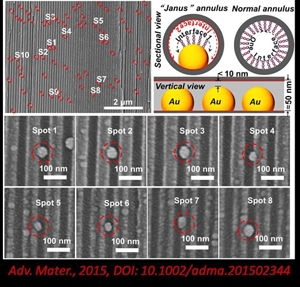On January 20th, a paper titled Functional “Janus” Annulus in Confined Channels, co-produced by research groups respectively led by Prof. Dr. Xia Fan from the School of Chemistry and Chemical Engineering (SCCE) and Prof. Dr. Zhai Tianyou from the School of Material Science and Engineering published in the Advanced Materials (Adv. Mater. 2016, 28, 460-465. IF 17.493), a top international journal.

In present work, for the first time, we develop a procedure to decorate Au nanoparticles (AuNPs) on the internal surface of confined channels in anodic aluminum oxide (AAO) membranes. The scattering AuNPs is with three geometric dimensions in nanoscale and found abundantly in the confined AAO channels. All AuNPs are sole in the annulus they inhabit and form a distinct interface with its uncovered AAO interface. The annulus consisting of the two different interface form a "Janus" structure and indendified as "Janus" annulus. Thanks to the confinedspaces (<10 nm) and ion perm selectivity by AuNPs decoration, the "Janus" annulus is endowed with a new function to characterize the self-assembly and hybridization by electrochemical impedance spectroscopy (EIS), which further distinguishes the single nucleotide polymorphisms (SNPs), particularly including terminal base polymorphisms, of a linear DNA chain. The first author in this paper is Dr. Pengcheng Gao, a postdoc from Prof. Xia’s group.
Prof. Dr Xia Fan (as below), who obtained his Bachelor’s Degree at SCCE of Hust, was introduced by SCCE in 2012. Through years of hard work, Prof. Dr. Xia Fan was officially granted the “National Science Fund for Distinguished Young Scholars” in 2015, becoming the first winner in SCCE. Recently, scientific papers produced by Professor Xia Fan’s research group have improved in quality significantly with many of them successively published on top SCI-recognized journals such as Advanced Materials and NPG Asia Materials.
Despite the existing heavy researches on diabetes detection in medical science, Prof. Dr Xia’s research group designated using a special aggregation-induced emission (AIE) molecule, which can interact specifically with glucose in an oligomerization reaction. This reaction can lead to the formation of oligomers which, when used in a nanochannel, open and close the channel via an “onion-like” intermediate state, reflecting the gating mechanism of molecules within the channel lumen. Based on these observations, they proposed a novel “onion-like” gating mechanism. Simultaneously, the AIE, stimulated after its aggregation with glucose, produces highly-luminescent fluorescence which in turn, serves as a more efficient means for detecting glucose in experiments. This novel dual-sign-output nanochannels system which involves the combination of ion current signal (used in old detection method) and the molecule fluorescence imaging, has been put into good use in the clinical test of diabetes patients’ urine specimens. And the paper Coordination of Electrical and Optical Signals Revealing the Nanochannel with “Onion-like” Gating Mechanism and its Sensing Application accomplished by doctoral student Xu Xuemei in 2015 grade under the guidance of associate professor Dr. Lou Xiaoding from the Prof. Dr. Xia’s research group, is published online by NPG Asia Materials.
In addition, the serial papers accomplished by doctoral student Zhuang Yuan in 2015 grade (from Professor Xia’s group), under the guidance of Prof. Dr. Xia Fan and associate Professor Dr. Lou Xiaoding, are published on Analytical Chemistry, a journal affiliated to the American Chemical Society (a professional organization in Chemistry). Among the papers, Real-Time, Quantitative Lighting-up Detection of Telomerase in Urines of Bladder Cancer Patients by AIEgens and Quencher Group Induced High Specificity Detection of Telomerase in Clear and Bloody Urines by AIEgens are selected and recommended by Global Medical Discovery (GMD) [ISSN 1929-8536] , a Canada-based medical research news company, to be published as a key medical diagnostics article. These papers proposed a new method of high efficiency, high sensitivity and high specifity for detecting the activity of telomerase and thereby provided such a new approach to selecting anti-cancer medicines and applying telomerase in cancer diagnostics. The method has been attested by over a hundred patients’ urine specimens.
It is mentioned that the above scientific research work is funded by various institutions including the Department of Organization of CPC Central Committee, Ministry of Science and Technology of P. R. C, National Natural Science Foundation of China and the Huazhong University of Science and Technology etc.
